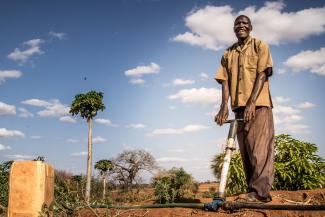OVERVIEW
The agricultural sector is the backbone of the economy, contributing approximately 33 percent of Kenya’s Gross Domestic Product (GDP). The agriculture sector employs more than 40 percent of the total population and 70 percent of the rural population. However, agricultural productivity has stagnated in recent years. Smallholder farmers and agricultural enterprises continue to face challenges growing their businesses and improving the quality of agricultural goods. We work to enhance agriculture-led economic growth, improve nutrition outcomes, strengthen county government capacity, increase resilience, and build sustainable market systems through private sector engagement.
PROGRAM AREAS
Increasing food security
As part of the Feed the Future initiative, USAID brings partners together to address the root causes of hunger and poverty. We work to enhance food security and increase incomes through improving the competitiveness and diversity of agricultural market systems and livelihoods. The initiative focuses on four main value chains: dairy, livestock, horticulture, and staple foods. We link farmers to markets and modern farming practices, improve quality and supply of agricultural inputs, increase access to financing, and promote private sector solutions.
Building resilience of vulnerable communities
Feed the Future aims to reduce the need for recurrent humanitarian assistance by accelerating economic growth for vulnerable communities to be able to withstand shocks. Our programs focus on regions in Kenya that experience cyclic shocks, where livestock is central to the economy, and rainfall is increasingly sporadic. USAID also helps pastoralists earn more money from their herds, prevents diseases through increased access to water and sanitation, and improves the management of drought-prone rangelands. Despite the presence of the COVID-19 pandemic, USAID activities continue to strengthen vulnerable households by supporting livelihood diversification, increasing access to animal health services, and increasing sustainable management of grazing areas.
The Horn of Africa crisis in 2011 changed USAID’s approach with a strategic shift to begin co-locating long-term development and humanitarian assistance investments to build household and systems level resilience to prepare for future climatic, conflict, and disease triggered shocks. We work at the community, county, and national level to prepare for climatic shocks like droughts and floods. At the local community level, we have supported communities to create action plans to guide their development priorities. At the county level, county governments have developed sector plans in rangelands and drought management, while at national level, we have worked with the National Drought Management Authority to develop its plan for drought risk management.
Improving nutrition and access to clean water and sanitation
Inadequate nutrition in children under age five stunts their growth and development. Undernutrition puts children at greater risk of dying from common infections, increases the frequency and severity of such infections, and delays recovery. We increase access to diverse and quality foods to improve the health of women and children. Diarrheal diseases are the third leading cause of death in children under age five. Access to household water, sanitation, and hygiene services affects nutritional status by reducing diarrheal and other infectious diseases, reducing parasitic infections, and reducing pathogenic environments that lead to gut malfunction and poor absorption of nutrients.
However, only 62% of Kenyans have access to improved drinking water. Even fewer (26%) have access to improved sanitation. To maximize our efforts, USAID integrates water and sanitation programs with programs focused on nutrition, agriculture, and health. We partner with the government, the private sector, and civil society to strengthen the systems that ensure sufficient water and sanitation service delivery to improve the health and well-being of Kenyans. We focus on market-driven approaches to increase access to water and sanitation services, while protecting watersheds and water resources.
Private sector investment
USAID aims to create an enabling business environment at all stages of the value chain through expanded access to finance for farmers and agricultural enterprises, increasing private-sector investment and through policy dialogues at the national and county levels. We work towards a more competitive, vibrant, and inclusive agricultural market system, especially for women and youth. We support new ideas that improve the productivity and incomes of smallholder farmers. We also expand access to finance for farmers, entrepreneurs, and businesses. We operate an innovative credit facility that works with local financial institutions to unlock capital, providing loans to under-served borrowers, such as rural farmers and small and medium-sized businesses.
FACT SHEETS
Overview: Agriculture and Food Security
Partnership for Resilience and Economic Growth (PREG)
Activity Fact Sheets
Accelerating Institutional And Food Systems Development (AIFSD)
Kenya Crops and Dairy Market Systems (KCDMS)
Kenya Livestock Market Systems (LMS)
Southeastern Kenya Coordination Mechanism (SEK)
Water, Sanitation and Hygiene

Alex Maina/USAID
